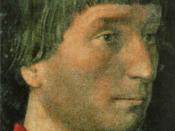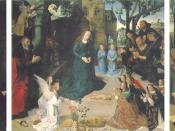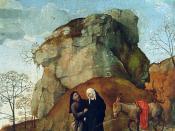One of Hugo van der Goes's most famous painting is, the Portinari Altarpiece. Portinari Altarpiece is said to be one of the last great Flemish altarpieces where symbolism is used significantly (Jen). The use of lots of symbolism is very common in the early 15th century (Jen). Hugo van der Goes broke the tradition of idealizing noble images of the past. He launched elements of realism into his altarpieces. The triptych altarpiece center panel measures 8'3 ý "x 10' and the side panels measures 8'3 ý "x 4'7 ý " each (Stokstad p. 635).
This extremely large altarpiece was commissioned by Tommaso Portinari who lived in Bruges, Italy, and managed the Medici bank (Galleria). Tommaso Portinari and his family are portrayed on the side panels (Britannica). Tommaso Portinari and his sons Anonio and Pigello are shown kneeling in the left panel, with Tommaso Portinari and his son Anonio's name saints standing larger then life behind them (Galleria).
His wife Maria and daughter Marghertia are also kneeling with their name saints Mary Magdalen and Margaret on the right panel (Galleria).
The Virgin Mary is placed in the center of the painting (Stokstad p. 634). She is kneeling on the ground with her hands folded in front of her. Her head is slightly tilted to the left and her eyes are almost closed. We can imply that she is in some kind of deep reflection, paying homage to the Christ Child who is lying nude on the ground in front of her. His nudity is a sign of his humbleness (Jen). Radiating out from under him while he is lying on the ground are beams of goldish light. With the exception of a few flying angles who are forming a circle around Christ, he is the center of attention for most of the figures in the painting. Almost all the figures that are focused on Christ have their folded hands and the same clam almost distressing facial expression as Mary.
At the far left painted, as an old man with gray messy hair, long beard, and wrinkled skin on his hands and face is Joseph (Stokstad p. 634). It is significant that he is painted as a noble looking man (Jen). Joseph has had a very troublesome role in the official church throughout the time (Jen). Joseph was looked upon as almost a joke: he was an old man married to the Virgin who remained a virgin her whole life Yet the more he got recognized the younger he became but in this piece he is still not that significant (). He is depicted as old and is placed in the side of the painting.
In front of Joseph, in the lower left of the panel, are two angles in white robes kneeling on the ground. They are also facing Christ. Their clothing is very fancy, they are dressed in what seems like very expensive robes, like those used by ministers during a mass, and their wings are white. The other angel's on the right have wings that include various colors, blue, red and yellow. Between the shepherds and Virgin Mary are another two angles. They dressed in simple blue robes. The five angles who are in the air five angles simple very clothing.
There are three shepherds in the upper right side of the center panel (Britannica). They show harsh realism, they are very far from the traditional idealized standard face of Mary and also of the angles, that was never seen before in Northern European painting (Jen). I think that Hugo van der Goes made the shepherd so realistic because he could emphasize that even though the shepherds are humble ordinary men, they are also invited to the adoration of Christ; that Christ is the redeemer for everyone, no matter what their social status is.
In the very front of the painting are some flowers and a sheaf of wheat. To the left, in front of the wheat, is a jar with five flowers, two orange, two white and one blue. To the right of these flowers is a glass with seven blue and three deep red flowers. The total number of flowers is fifteen, which is a sacred number. Fifteen was the most important number connected with Mary (Encyclopedia p.97). She climbed fifteen steps at the age of three, when she was presented to the High Priest (Encyclopedia p.97). She had fifteen male suitors before she married Joseph (Encyclopedia p.97). But most importantly, she was fifteen when she gave birth to Christ. There are also fifteen angles in the painting (Britannica p.97).
Behind the figures in the center there is a stable and a palace. The stable is supposed to be the stable in Bethlehem, in the city of David, in which Christ was born (Jen). The palace in the background is the palace of David (Jen). The palace is falling apart, symbolizing that the New Testament supersedes the Old Testament (Jen). In the stable, in the darkness above the head of the ox, some sort of creature can be seen very faintly, it's a demon (Jen).
An odd aspect of this painting is that all of the female figures have the same facial characteristics, but Hugo van der Goes was not concerned with linear perspective or about the scale of the figures. The structure of the circle of figures around the naked Christ Child at first glance looks randomly put together, but then when you really look at it, you find it's very cleaver. What Hugo van der Goes did with his Portinari Altarpiece was to created the last big altarpiece where extensive symbolism was used.
Works Referenced and Works Sited Britannica, Hugo van der Goes. January 25, 2001. Encyclopedia, Britannica, The New Encyclopedia Britannica: Volume 17. Chicago, Encyclopedia Britannica Inc, 1998.
Galleria degli Uffizi, Hugo van der Goes, Portinari Tiprych. January 27, 2001. Hugo van der Goes, Hugo van der Goes. January 27, 2001. Jen's Hompage. Art History: Hugo van der Goesis; Portinari Altarpiece. January 23, 2001. Kren, Emil and Daniel Marx, Web Gallery of Art. Hugo van der Goes, January 27, 200. Stokstad, Marilyn. Art History Volume Two. New York, Harry N. Adams Inc, 1995.





